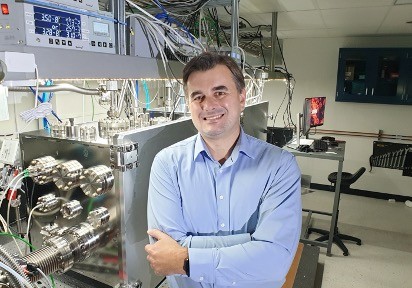Understanding and controlling new phases of matter using ultrafast linear and nonlinear X-ray probes
Presented by Prof. Michael Zuerch
Hosted by Prof. Xiaoyang Zhu
Abstract:
Our group specializes in ultrafast spectroscopic methods, enabling in-depth studies of material chemistry in intricate environments and the control of quantum phenomena on femtosecond timescales. In the first part of this seminar, I will discuss the role of lithium in various systems from its contribution to symmetry breaking (LiNbO3), to an exotic quantum material (polar metal LiOsO3), to unravel the reasons behind the low hopping rate of lithium ions at the surface of a solid-state electrolyte (LixLa(2-x)/3TiO3). All these systems share the common feature that Li occupies a symmetry-broken state which we can selectively probe using extreme-ultraviolet second-harmonic generation spectroscopy (XUV-SHG), a novel spectroscopy pioneered in my group. In the second part I will discuss recent results on 1T-TiSe2, a prototypical charge-density-wave (CDW) compound that also exhibits strong excitonic correlations in its low-temperature phase. I will discuss how we unravel the interplay of these different aspects via cryogenic attosecond transient extreme-ultraviolet absorption spectroscopy (cryo-ATAS), for which we built a unique laboratory instrument, and mega-electron-volt ultrafast electron diffraction (MeV-UED). I will show how photoexcitation leads to a 3D-to-2D dimension crossover in the CDW order parameter, a process dictated by the excitonic correlations in the system. The excitonic effect is further evidenced in the initial response of selected core-level absorption edges, and these observations help pinpoint the specific role of excitonic correlations in the CDW transition. I will also illustrate the hidden 1D nature of the CDW and its implications for the formation mechanism of domain-wall-like topological defects, which are found to emerge well under one picosecond following photoexcitation.
Bio:
Prof. Zuerch received his PhD in 2014 from the Friedrich Schiller University in Jena, Germany. Following a post-doc at UC Berkeley (2015-2017) with Leone and Neumark, he started an independent Max Planck Research Group at the Fritz Haber Institute in Berlin. In 2019 he joined the Department of Chemistry at UC Berkeley as Assistant Professor and is also a faculty scientist at the Lawrence Berkeley National Laboratory. He and his team experimentally explore structural, carrier and spin dynamics in novel quantum materials, heterostructures and on surfaces and at interfaces to answer current questions in materials science and physical chemistry. In this pursuit his group develops novel methods such as extreme-ultraviolet second-harmonic generation spectroscopy and unique instruments such as a cryogenic attosecond transient absorption spectrometer. Since 2020 he is the director of the California Interfacial Science Institute which is an effort funded by the University of California to advance the understanding of chemical processes at interfaces through experiment and theory. His work on linear and nonlinear XUV spectroscopy has been awarded the Fresnel Prize 2021 of the European Physical Society. He was also named a Hellman Fellow and won an W. M. Keck Foundation Science and Engineering Research Award. In 2023 he was awarded the DOE Early Career award.
Learn more about the Zuerch Lab here!
References:
T. Helk et al., Sci. Adv. 7, eabe2265 (2021).
C. Uzundal et al., Phys. Rev. Lett. 127, 237402 (2021).
E. Berger et al., Nano Letters 21, 6095–6101 (2021).
Y. Cheng et al., Nature Communications 13, 963 (2022)
C. Woodahl et al., Nature Materials 22, 848 (2023)
A. Zong et al., Nature Reviews Materials 8, 224–240 (2023)
Y. Cheng et al., Nature Physics 20, 54–60 (2024)

